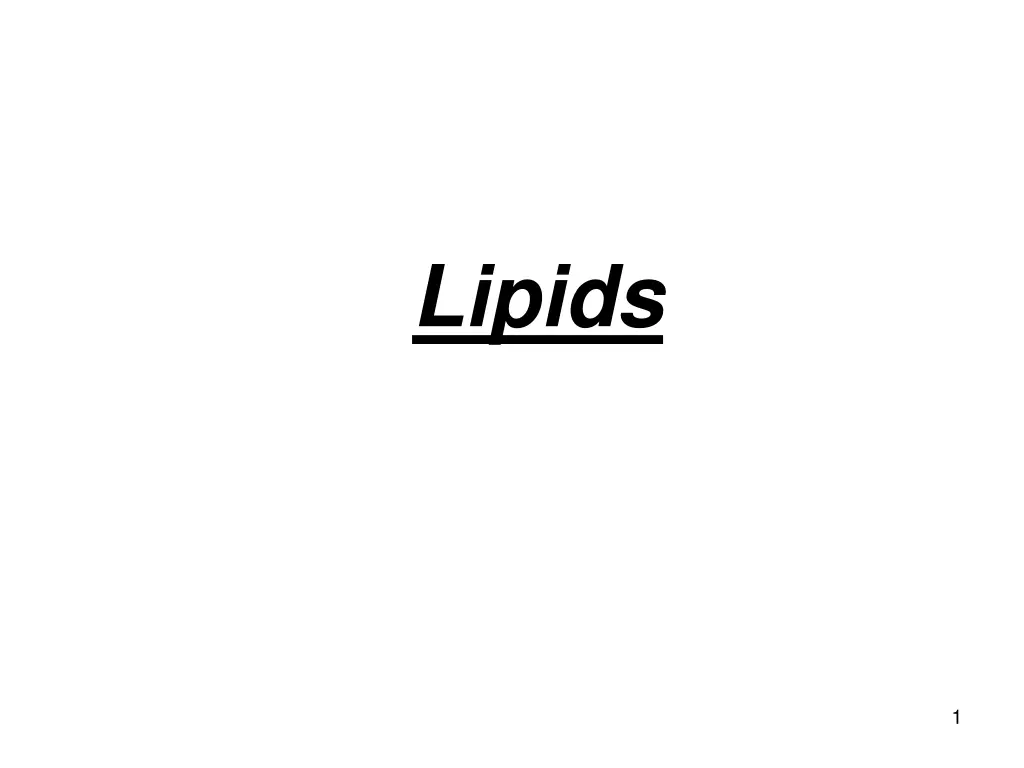
Understanding Lipids and Fatty Acids
Explore the world of lipids, including their types such as waxes, fats, and oils, as well as the structures and properties of fatty acids. Learn about saturated and unsaturated fatty acids, their molecular structures, and how they differ in terms of melting points and physical properties.
Download Presentation

Please find below an Image/Link to download the presentation.
The content on the website is provided AS IS for your information and personal use only. It may not be sold, licensed, or shared on other websites without obtaining consent from the author. If you encounter any issues during the download, it is possible that the publisher has removed the file from their server.
You are allowed to download the files provided on this website for personal or commercial use, subject to the condition that they are used lawfully. All files are the property of their respective owners.
The content on the website is provided AS IS for your information and personal use only. It may not be sold, licensed, or shared on other websites without obtaining consent from the author.
E N D
Presentation Transcript
Lipids 1
Lipids Lipids are Biomolecules that contain fatty acids or a steroid nucleus. Soluble in organic solvents but not in water. Named for the Greek word lipos, which means fat. Extracted from cells using organic solvents. 2
Types of Lipids The types of lipids containing fatty acids are Waxes. Fats and oils (triacylglycerols). Glycerophospholipids. Prostaglandins. 3
Fatty Acids Fatty acids Are long-chain carboxylic acids. Typically contain 12-18 carbon atoms. Are insoluble in water. Can be saturated or unsaturated. 6
Fatty Acid Formulas The formulas for fatty acids are written as Condensed formulas. Line-bond formulas. For example caprylic acid with 8 carbon atoms. CH3 (CH2)6 COOH CH3 CH2 CH2 CH2 CH2 CH2 CH2 COOH O OH 7
Saturated Fatty Acids Saturated fatty acids have Single C C bonds.Molecules that fit closely together in a regular pattern.Strong attractions between fatty acid chains.High melting points that make them solids at room temperature 8
Unsaturated Fatty Acids Unsaturated fatty acids Have one or more double C=C bond Typically contain cis double bonds. 10
Properties of Unsaturated Fatty Acids Unsaturated fatty acids Have kinks in the fatty acid chains. kinks in chain Do not pack closely. Have few attractions between chains. Have low melting points. Are liquids at room temperature. 11
Comparing Melting Pointsof Some Fatty Acids 13
Learning Check Assign the melting points of 17 C, 13 C, and 69 C to the correct fatty acid. Explain. stearic acid (18 C) saturated oleic acid (18 C) one double bond linoleic acid (18 C) two double bonds 14
Solution Stearic acid is saturated and would have a higher melting point than the unsaturated fatty acids. Because linoleic has two double bonds, it would have a lower mp than oleic acid, which has one double bond. stearic acid mp 69 C saturated oleic acid mp 13 C linoleic acid mp -17 C most unsaturated 15
Prostaglandins Prostaglandins have 20 carbon atoms in their fatty acid chains. An OH on carbon 11 and 15. A trans double bond at carbon 13. C 15 C 13 C 11 16
Prostaglandins in the Body Prostaglandins are Produced by injured tissues. Involved in pain, fever, and inflammation. Not produced when anti-inflammatory drugs such as aspirin inhibit their synthesis. 17
Omega-6 and Omega 3- Fatty Acids Fatty acids In vegetable oils are mostly omega-6 with the first C=C at C6. linoleic acid CH3 (CH2)4 CH=CH CH2 CH=CH (CH2)7 COOH 6 In fish oils are mostly omega-3 with the first C=C at C3. linolenic acid CH3 CH2 (CH=CH CH2)3 (CH2)6 COOH 3 18
Some Omega-6 and Omega-3 Fatty Acids 19
Learning Check Write a fatty acid with 10 carbon atoms that is: A. saturated B. monounsaturated omega-3 C. monounsaturated omega-6 20
Solution Write a fatty acid with 10 carbon atoms that is:A. saturated CH3 CH2 CH2 CH2 CH2 CH2 CH2 CH2 CH2 COOH B. monounsaturated omega-3 CH3 CH2 CH=CH CH2 CH2 CH2 CH2 CH2 COOH C. monounsaturated omega-6 CH3 CH2 CH2 CH2 CH2 CH=CH CH2 CH2 COOH 21
